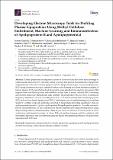Files in this item
Developing electron microscopy tools for profiling plasma lipoproteins using methyl cellulose embedment, machine learning and immunodetection of apolipoprotein B and apolipoprotein(a)
Item metadata
| dc.contributor.author | Giesecke, Yvonne | |
| dc.contributor.author | Soete, Samuel | |
| dc.contributor.author | MacKinnon, Katarzyna | |
| dc.contributor.author | Tsiaras, Thanasis | |
| dc.contributor.author | Ward, Madeline | |
| dc.contributor.author | Althobaiti, Mohammed | |
| dc.contributor.author | Suveges, Tamas | |
| dc.contributor.author | Lucocq, James E. | |
| dc.contributor.author | McKenna, Stephen J. | |
| dc.contributor.author | Lucocq, John M. | |
| dc.date.accessioned | 2021-09-29T16:30:03Z | |
| dc.date.available | 2021-09-29T16:30:03Z | |
| dc.date.issued | 2020-09-02 | |
| dc.identifier | 269485699 | |
| dc.identifier | ff5af4c5-6ab9-460f-b683-201c9f382177 | |
| dc.identifier | 85090511295 | |
| dc.identifier | 000570371000001 | |
| dc.identifier.citation | Giesecke , Y , Soete , S , MacKinnon , K , Tsiaras , T , Ward , M , Althobaiti , M , Suveges , T , Lucocq , J E , McKenna , S J & Lucocq , J M 2020 , ' Developing electron microscopy tools for profiling plasma lipoproteins using methyl cellulose embedment, machine learning and immunodetection of apolipoprotein B and apolipoprotein(a) ' , International Journal of Molecular Sciences , vol. 21 , no. 17 , 6373 . https://doi.org/10.3390/ijms21176373 | en |
| dc.identifier.issn | 1422-0067 | |
| dc.identifier.other | Bibtex: ijms21176373 | |
| dc.identifier.other | Bibtex: ijms21176373 | |
| dc.identifier.other | ORCID: /0000-0002-5191-0093/work/101217947 | |
| dc.identifier.uri | https://hdl.handle.net/10023/24058 | |
| dc.description.abstract | Plasma lipoproteins are important carriers of cholesterol and have been linked strongly to cardiovascular disease (CVD). Our study aimed to achieve fine-grained measurements of lipoprotein subpopulations such as low-density lipoprotein (LDL), lipoprotein(a) (Lp(a), or remnant lipoproteins (RLP) using electron microscopy combined with machine learning tools from microliter samples of human plasma. In the reported method, lipoproteins were absorbed onto electron microscopy (EM) support films from diluted plasma and embedded in thin films of methyl cellulose (MC) containing mixed metal stains, providing intense edge contrast. The results show that LPs have a continuous frequency distribution of sizes, extending from LDL (> 15 nm) to intermediate density lipoprotein (IDL) and very low-density lipoproteins (VLDL). Furthermore, mixed metal staining produces striking “positive” contrast of specific antibodies attached to lipoproteins providing quantitative data on apolipoprotein(a)-positive Lp(a) or apolipoprotein B (ApoB)-positive particles. To enable automatic particle characterization, we also demonstrated efficient segmentation of lipoprotein particles using deep learning software characterized by a Mask Region-based Convolutional Neural Networks (R-CNN) architecture with transfer learning. In future, EM and machine learning could be combined with microarray deposition and automated imaging for higher throughput quantitation of lipoproteins associated with CVD risk. | |
| dc.format.extent | 25 | |
| dc.format.extent | 7869414 | |
| dc.language.iso | eng | |
| dc.relation.ispartof | International Journal of Molecular Sciences | en |
| dc.subject | Lipoproteins | en |
| dc.subject | Nanoparticles | en |
| dc.subject | Low-density lipoproteins | en |
| dc.subject | Apolipoprotein B | en |
| dc.subject | Apolipoprotein(a) | en |
| dc.subject | Electron microscopy | en |
| dc.subject | Cardiovascular disease | en |
| dc.subject | Machine learning | en |
| dc.subject | QH301 Biology | en |
| dc.subject | QR180 Immunology | en |
| dc.subject | NDAS | en |
| dc.subject | SDG 3 - Good Health and Well-being | en |
| dc.subject.lcc | QH301 | en |
| dc.subject.lcc | QR180 | en |
| dc.title | Developing electron microscopy tools for profiling plasma lipoproteins using methyl cellulose embedment, machine learning and immunodetection of apolipoprotein B and apolipoprotein(a) | en |
| dc.type | Journal article | en |
| dc.contributor.institution | University of St Andrews. School of Medicine | en |
| dc.contributor.institution | University of St Andrews. Cellular Medicine Division | en |
| dc.contributor.institution | University of St Andrews. Biomedical Sciences Research Complex | en |
| dc.identifier.doi | 10.3390/ijms21176373 | |
| dc.description.status | Peer reviewed | en |
| dc.identifier.url | https://www.mdpi.com/journal/ijms/sections/Pathology_Diagnostics_Therapeutics | en |
This item appears in the following Collection(s)
Items in the St Andrews Research Repository are protected by copyright, with all rights reserved, unless otherwise indicated.

